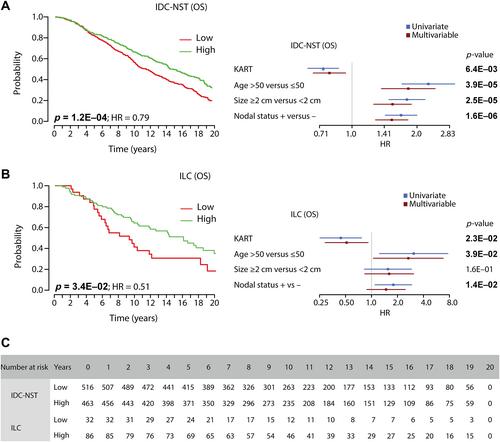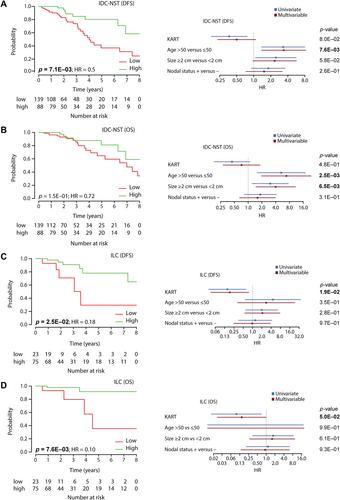Thijmen Sijnesael, François Richard, Max AK Rätze, Thijs Koorman, Blessing Bassey-Archibong, Christa Rohof, Juliet Daniel, Christine Desmedt, Patrick WB Derksen
下载PDF
{"title":"典型Kaiso靶基因定义了与乳腺癌生存和浸润性小叶癌组织学类型相关的功能特征","authors":"Thijmen Sijnesael, François Richard, Max AK Rätze, Thijs Koorman, Blessing Bassey-Archibong, Christa Rohof, Juliet Daniel, Christine Desmedt, Patrick WB Derksen","doi":"10.1002/path.6205","DOIUrl":null,"url":null,"abstract":"<p>Invasive lobular carcinoma (ILC) is a low- to intermediate-grade histological breast cancer type caused by mutational inactivation of E-cadherin function, resulting in the acquisition of anchorage independence (anoikis resistance). Most ILC cases express estrogen receptors, but options are limited in relapsed endocrine-refractory disease as ILC tends to be less responsive to standard chemotherapy. Moreover, ILC can relapse after >15 years, an event that currently cannot be predicted. E-cadherin inactivation leads to p120-catenin-dependent relief of the transcriptional repressor Kaiso (ZBTB33) and activation of canonical Kaiso target genes. Here, we examined whether an anchorage-independent and ILC-specific transcriptional program correlated with clinical parameters in breast cancer. Based on the presence of a canonical Kaiso-binding consensus sequence (cKBS) in the promoters of genes that are upregulated under anchorage-independent conditions, we defined an ILC-specific anoikis resistance transcriptome (ART). Converting the ART genes into human orthologs and adding published Kaiso target genes resulted in the Kaiso-specific ART (KART) 33-gene signature, used subsequently to study correlations with histological and clinical variables in primary breast cancer. Using publicly available data for ER<sup>POS</sup>Her2<sup>NEG</sup> breast cancer, we found that expression of KART was positively associated with the histological ILC breast cancer type (<i>p</i> < 2.7E-07). KART expression associated with younger patients in all invasive breast cancers and smaller tumors in invasive ductal carcinoma of no special type (IDC-NST) (<2 cm, <i>p</i> < 6.3E-10). We observed associations with favorable long-term prognosis in both ILC (hazard ratio [HR] = 0.51, 95% CI = 0.29–0.91, <i>p</i> < 3.4E-02) and IDC-NST (HR = 0.79, 95% CI = 0.66–0.93, <i>p</i> < 1.2E-04). Our analysis thus defines a new mRNA expression signature for human breast cancer based on canonical Kaiso target genes that are upregulated in E-cadherin deficient ILC. The KART signature may enable a deeper understanding of ILC biology and etiology. © 2023 The Authors. <i>The Journal of Pathology</i> published by John Wiley & Sons Ltd on behalf of The Pathological Society of Great Britain and Ireland.</p>","PeriodicalId":232,"journal":{"name":"The Journal of Pathology","volume":"261 4","pages":"477-489"},"PeriodicalIF":5.6000,"publicationDate":"2023-09-22","publicationTypes":"Journal Article","fieldsOfStudy":null,"isOpenAccess":false,"openAccessPdf":"https://pathsocjournals.onlinelibrary.wiley.com/doi/epdf/10.1002/path.6205","citationCount":"0","resultStr":"{\"title\":\"Canonical Kaiso target genes define a functional signature that associates with breast cancer survival and the invasive lobular carcinoma histological type\",\"authors\":\"Thijmen Sijnesael, François Richard, Max AK Rätze, Thijs Koorman, Blessing Bassey-Archibong, Christa Rohof, Juliet Daniel, Christine Desmedt, Patrick WB Derksen\",\"doi\":\"10.1002/path.6205\",\"DOIUrl\":null,\"url\":null,\"abstract\":\"<p>Invasive lobular carcinoma (ILC) is a low- to intermediate-grade histological breast cancer type caused by mutational inactivation of E-cadherin function, resulting in the acquisition of anchorage independence (anoikis resistance). Most ILC cases express estrogen receptors, but options are limited in relapsed endocrine-refractory disease as ILC tends to be less responsive to standard chemotherapy. Moreover, ILC can relapse after >15 years, an event that currently cannot be predicted. E-cadherin inactivation leads to p120-catenin-dependent relief of the transcriptional repressor Kaiso (ZBTB33) and activation of canonical Kaiso target genes. Here, we examined whether an anchorage-independent and ILC-specific transcriptional program correlated with clinical parameters in breast cancer. Based on the presence of a canonical Kaiso-binding consensus sequence (cKBS) in the promoters of genes that are upregulated under anchorage-independent conditions, we defined an ILC-specific anoikis resistance transcriptome (ART). Converting the ART genes into human orthologs and adding published Kaiso target genes resulted in the Kaiso-specific ART (KART) 33-gene signature, used subsequently to study correlations with histological and clinical variables in primary breast cancer. Using publicly available data for ER<sup>POS</sup>Her2<sup>NEG</sup> breast cancer, we found that expression of KART was positively associated with the histological ILC breast cancer type (<i>p</i> < 2.7E-07). KART expression associated with younger patients in all invasive breast cancers and smaller tumors in invasive ductal carcinoma of no special type (IDC-NST) (<2 cm, <i>p</i> < 6.3E-10). We observed associations with favorable long-term prognosis in both ILC (hazard ratio [HR] = 0.51, 95% CI = 0.29–0.91, <i>p</i> < 3.4E-02) and IDC-NST (HR = 0.79, 95% CI = 0.66–0.93, <i>p</i> < 1.2E-04). Our analysis thus defines a new mRNA expression signature for human breast cancer based on canonical Kaiso target genes that are upregulated in E-cadherin deficient ILC. The KART signature may enable a deeper understanding of ILC biology and etiology. © 2023 The Authors. <i>The Journal of Pathology</i> published by John Wiley & Sons Ltd on behalf of The Pathological Society of Great Britain and Ireland.</p>\",\"PeriodicalId\":232,\"journal\":{\"name\":\"The Journal of Pathology\",\"volume\":\"261 4\",\"pages\":\"477-489\"},\"PeriodicalIF\":5.6000,\"publicationDate\":\"2023-09-22\",\"publicationTypes\":\"Journal Article\",\"fieldsOfStudy\":null,\"isOpenAccess\":false,\"openAccessPdf\":\"https://pathsocjournals.onlinelibrary.wiley.com/doi/epdf/10.1002/path.6205\",\"citationCount\":\"0\",\"resultStr\":null,\"platform\":\"Semanticscholar\",\"paperid\":null,\"PeriodicalName\":\"The Journal of Pathology\",\"FirstCategoryId\":\"3\",\"ListUrlMain\":\"https://onlinelibrary.wiley.com/doi/10.1002/path.6205\",\"RegionNum\":2,\"RegionCategory\":\"医学\",\"ArticlePicture\":[],\"TitleCN\":null,\"AbstractTextCN\":null,\"PMCID\":null,\"EPubDate\":\"\",\"PubModel\":\"\",\"JCR\":\"Q1\",\"JCRName\":\"ONCOLOGY\",\"Score\":null,\"Total\":0}","platform":"Semanticscholar","paperid":null,"PeriodicalName":"The Journal of Pathology","FirstCategoryId":"3","ListUrlMain":"https://onlinelibrary.wiley.com/doi/10.1002/path.6205","RegionNum":2,"RegionCategory":"医学","ArticlePicture":[],"TitleCN":null,"AbstractTextCN":null,"PMCID":null,"EPubDate":"","PubModel":"","JCR":"Q1","JCRName":"ONCOLOGY","Score":null,"Total":0}
引用次数: 0
引用
批量引用



 求助内容:
求助内容: 应助结果提醒方式:
应助结果提醒方式:


